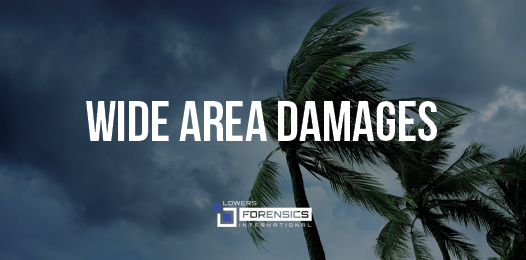Monsoon flooding in India. Wildfires in California. Earthquakes and tsunamis in Indonesia. Volcanic eruptions in Guatemala. Hurricane Maria in Puerto Rico.
These recent catastrophes each left massive, widespread destruction in their wake. Thousands of lives were lost, businesses were destroyed, and communities suffered long-term economic losses.
Wide impact disasters like these present unique challenges for settling business interruption claims. In this blog, we’ll explore what those obstacles are and highlight how the insurance industry is responding.
Wide Area Damages (WAD): A Different Breed
Business interruption (BI) insurance generally covers lost business income caused by an event that interrupts the operations of the business, such as a natural disaster, faulty machinery, or fire. It’s usually added to a property/casualty policy or included in a comprehensive package policy, rather than offered as a standalone policy.
In a standard BI claim, the insured’s business is generally covered for losses during the period it takes to restore the business to its original condition. BI policies can cover the profits the business would’ve earned, operating expenses (e.g., employee wages, loan payments, taxes), and the expenses of moving to a temporary location. Coverage often starts a few days after the incident and lasts until the business location becomes operable again, though “extended” and “contingent” BI policies can be purchased to handle extenuating circumstances.
Settlements are determined using the business’ records of income and expenses. Given that the completeness and availability of those records vary from business to business, defining the parameters of a BI claim makes them one of the most difficult and hotly disputed types of claims. In a catastrophic disaster where wide area damages are prevalent, this challenge is only amplified. That’s because the economic impact of wide-area damages may take months to be realized.
Valuating the initial physical damage to buildings, equipment, or inventory may be straightforward. Other factors that contribute to revenue losses, however, can be harder to calculate and may take months for a forensic accounting team to sort through. These complicating dynamics may include:
- The inability to restore financial records and other data for businesses that didn’t have disaster recovery plans in place
- Lack of physical access to the site due to destroyed roads, flooding, or damaged infrastructure
- A shortage of repair resources, both labor and materials
- Loss of vital services (e.g., electricity, water, gas)
- Damage throughout the supply chain, from suppliers to distributors to customers
From a business interruption standpoint, wide-area damage may prolong the period of indemnity well beyond expected timeframes.
The Impact of WAD Worldwide
Globally, natural disasters are estimated to cost a third of a trillion dollars a year, on average. According to the World Bank, that’s more than twice the size of all official development assistance—the money developed countries set aside to help developing ones.
Munich Re reports that only 16 percent of total losses from natural catastrophic events are insured, with variations from country to country. In the U.S., the figure is 64 percent while it is as low as one percent in some areas of Asia.
The company recently released disaster statistics for the first half of 2019, stating, “A striking feature of the loss statistics…is the high proportion of losses affecting poorer countries. Three of the five costliest disasters affected emerging and developing countries. These included a flood disaster in Iran (overall losses of $2.5 billion*), and storm and flood losses from Cyclone Fani in India and Bangladesh in May ($2.2 billion).”
Mozambique, one of the world’s poorest countries, was particularly hard hit when Cyclone Idai made landfall in March near the port of Beira, which has 500,000 inhabitants. Wind speeds of 170 km/h wrecked a huge number of homes and buildings, most of which were simple structures. In combination with the heavy rainfall, the flood wave from the storm triggered flooding over the flat coastal terrain that extended far inland. Overall losses in Mozambique and neighboring countries came to approximately $2 billion, Munich Re reports. The loss in Mozambique is equivalent to around one-tenth of the country’s gross domestic product (GDP) – an enormous burden.
The poor suffer disproportionately when a wide-area disaster occurs. “They are more exposed, more vulnerable, and less able to recover,” notes the World Bank. Poor building materials, proximity to flood plains, and lack of insurance mean poorer families are likely to lose a larger share of their assets when a hurricane or other natural disaster strikes.
In fact, research shows that every year natural disasters trap some 26 million people in extreme poverty, defined as living on $1.90 per day or less.
The Ripple Effect
In 2018, there were $225 billion in economic losses across the world due to natural disasters, of which $90 billion was insured. They include:
- Typhoon Mangkhut (Oceana, East Asia) – $6 billion in damage, 163 deaths
- Hurricane Florence (USA) – $15 billion in losses, 53 deaths
- Earthquake (Papua New Guinea) – a 7.5 magnitude earthquake struck, triggering aftershocks and landslides; 500,000 people were affected and 145 people died
- Flooding (Japan) – $10 billion in economic losses, 246 deaths
- California Camp Fire (USA) – $15 billion in damage, 1.82 million acres burned
- Tropical Storm Rumbia (China) – $5.4 billion in losses, 53 deaths
- Flooding (Nigeria) – 12 states and 2 million people affected, 13,000 homes destroyed, 200 deaths
Hurricanes, tornadoes, and earthquakes are a part of life in many areas of the world, yet with any natural disaster, some areas get harder than others.
The initial damage to a business structure may be somewhat modest relative to the financial losses the incident triggers. For example, in a WAD, roads, electricity, and other types of infrastructure are often damaged, preventing the delivery of raw materials to the business. In others, customers are unable to reach the business or may have even been evacuated entirely.
Depending on the geographic scope of the damage, resources that are normally brought to bear (e.g., construction equipment to remove debris, laborers to fix buildings, Internet to restore backup files) may not be available because surrounding areas have also been hit.
The initial focus in extreme catastrophes is simply getting basic humanitarian aid to residents, which requires focusing on establishing physical access to the disaster site, restoring power, and distributing food and water.
These confounding obstacles make determining revenue losses in BI claims extremely complex and their settlement timeframes variable.
BI Claims Accounting in WADs
Even in the absence of a WAD event, BI claims accounting is subject to some interpretation. It will generally cover lost income, operating expenses, and temporary relocation costs. It may not, however, cover income that isn’t documented, utilities, losses from a partial business closure, or flood damage.
When you add the complications usually associated with a WAD (e.g., lack of power, supply chain obstacles, etc.), BI valuation becomes even more complex.
“The indemnity period varies in gross profits policies used globally versus gross earnings policies typically used in the U.S. where the indemnity period needs to be set up front,” said Caroline Woolley, Marsh’s Business Interruption Center of Excellence leader, in an article by the Insurance Journal. She said that while it is common to opt for a standard 12 months in gross profits, that is rarely enough.”
Another complicating factor in measuring wide impact catastrophes is the approach that is taken, either “Economy Considered’ or “Economy Ignored.” The Pillsbury law firm explains it this way, “The Economy Ignored approach looks backward and measures the policyholder’s loss only against pre-catastrophe business levels and does not take into consideration the impact of actual post-catastrophe conditions on the economy, market or demand. Courts that apply the Economy Ignored approach typically do so because they are more concerned that the policyholder will reap a “windfall” from the catastrophe. The Economy Considered approach, on the other hand, seeks to place the policyholder in the position that it would have occupied in the actual post-catastrophe environment had it been able to continue its operations, which avoids giving an insurer a “windfall.””
Neither approach consistently benefits a policyholder or an insurer in every situation. The outcomes, instead, rely on the unique facts and circumstances of the loss.
One of the fundamental limitations of BI coverage in WAD scenarios is that the policy language often pre-dates the realities and diversity of today’s businesses. As such, Wooley said the top five BI issues for insurers are:
- Getting the values right
- Settling the indemnity period
- Damage covering a wide area
- Inadequate supply chain coverage
- Lengthy and intensely scrutinized claims settlement processes
How the Insurance Industry Is Responding
Insurers are getting more restrictive in WAD coverage. They are excluding certain territories and types of catastrophic events, as well as scrutinizing BI claims more carefully. This shift is happening at all levels, from policy language to indemnity periods to risk mitigation with the insured.
Policy Extensions
A basic BI policy will cover business losses stemming from damage to the insured’s property, but in the case of a wide impact event, policy extensions are being added to broaden the coverage. For example, in the United Kingdom, additional contingencies can be added for Fire and Special Perils (e.g., fires, gas explosions) or Engineering (e.g., failure of public utilities). In the U.S., there are Civil Authority clauses (to cover actions of local police or fire) and Loss of Attraction contingencies (for loss of income from damage to a nearby business or landmark).
These extensions add to the cost of the premium, but they can be instrumental in determining whether a business will survive a WAD or not. In nearly every example, the indemnity period, coverages, deductibles, and waiting periods are clearly defined.
Mitigating Risks & Leveraging Technology
The insurance industry is taking strides to respond more quickly to wide area disasters, while at the same time attempting to better predict claim valuations. They’re using a multi-pronged approach of proactively preparing businesses, clarifying coverage limits, and leveraging data and technology.
They are working with businesses to:
- Create business continuity/disaster recovery plans
- Use remote, offsite cloud storage to backup all important data
- Fully document the potential financial impact of a business interruption, both short- and long-term
- Document key components of manufacturing, supply, and distribution chains
- Identify all potential areas of loss and document what they would be post-loss
They’re also leveraging technology to eliminate paper files and, instead, using scanning and other digital tools to document losses and send them immediately to all stakeholders. In other cases, the insurer will send drones to evaluate damage in advance of a site visit. Risk managers are also modifying outdated language and verifying that policy wording, extensions, and limits are correct and that they work for a range of business types.
Experience Matters
Business interruption claims in WAD scenarios are one of the most complex claim types, and an experienced forensic accounting team is absolutely essential. If you’d like to learn more about our team’s experience in settling worldwide claims under the most challenging of disaster environments, contact us today.





